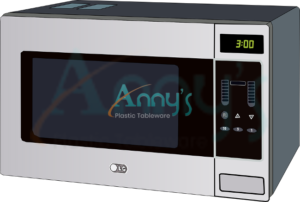Over 9 of 10 American households own a microwave oven. However, how they work is still confusing to people who use them, especially due to warnings and viral videos found on the World Wide Web.

Microwave ovens are a type of electromagnetic energy that causes moisture in food to produce heat. Opposed to popular opinion, microwaves cook a food’s outer surface first, then the heat works its way inside of the food. This is known as “nuking”, although this has no relation to nuclear energy.
Microwaves are all required to meet federal safety regulations, and all microwaves should not be able to heat when their doors are open. Microwaves can leak, and when they do, they are capable of causing harm to humans, so the amount of leakage allowed is very minimal. But do not worry. For as long as you are able to close the microwave door without problem, your microwave is fine.
There is a limit to what materials can be used inside a microwave to cook with foods. Regarding paper and plastic, there are some types of these materials that are safe for microwaving, and there are some that are not. Ceramic and glass bowls and plates are ideal for heating in a microwave, but you can also use disposable plastic food containers that are labeled as microwave safe. Some plastic trays can only be put in the microwave once, and putting them in again can cause the plastic to warp, melt, or transfer chemicals to foods inside of it. Papers including wax paper, parchment paper, paper plates, and paper towels are all considered safe for the microwave. Thick paper like newspapers and brown bags are not.
Metal and aluminum have strange properties, and they are not recommended for using to cook foods because the microwaves rays bounce right off of them. This means that they won’t be able to help cook foods properly, and are likely to cause fired inside of the microwave. Thin metals like foil can cause air to become electrified, and can cause sparks to go off in your microwave. Avoid aluminum foil unless instructed by packaging on certain food products. In most cases, disposable plastic food containers are safer to use in microwaves than metal.
Plastic wraps used to contain chemicals known as plasticizers, but most brands no longer have products with these anymore. Regardless, plastic is still capable of melting into your food, so be sure to buy plastic wrap that is microwave safe and microwave it in a way that it does not come into contact with the food. You can also cover bowls of food with a paper towel for microwave use.
Microwaves are capable of cooking food to a safe temperature, but microwaves can also cook foods unevenly, making some areas warmer than others. In colder areas, bacteria can spread and multiply. If your microwave does not have a turntable, rotate your dish or bowl in multiple phases of the microwave process to ensure that each area is heated properly. For liquid-solid foods like mashed potatoes, sauces, and more, stir it in between heating sessions so that it all gets even amounts of heat applied.
Microwaves do not produce hostile compounds in food, and foods cooked in a microwave are just as safe to eat as foods cooked with a conventional oven. Microwaving, however, uses less energy than basic kitchen ovens and stoves. This is due to two important factors: The microwave takes much less time to heat food, and the microwave cooks only the food inside of it, not the air as well.